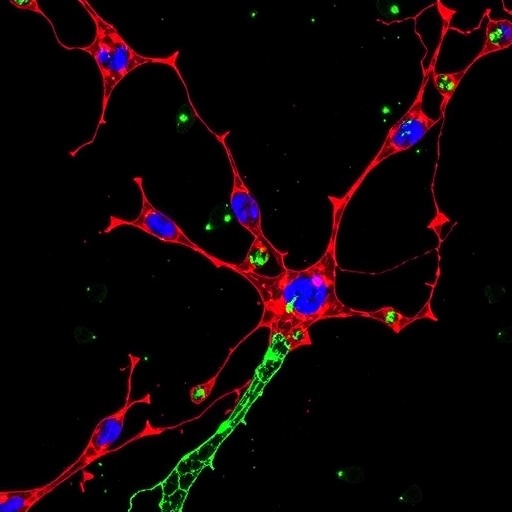In a landmark study poised to redefine therapeutic strategies against breast cancer, researchers have uncovered a potent molecular mechanism that curbs unchecked proliferation in MCF-7 breast cancer cells, a widely studied estrogen receptor-positive cell line. Central to this discovery is the microRNA miR-32-5p, a small non-coding RNA molecule whose modulation presents a promising avenue for cancer treatment by targeting the notorious oncogene c-MYC. This breakthrough highlights the intricate regulatory networks that underlie cancer cell survival and opens a promising window for developing more precise, less toxic interventions against breast malignancies driven by c-MYC overexpression.
The c-MYC oncogene has long been recognized as a master regulator of cellular growth and metabolism, frequently upregulated in various cancers, including breast carcinoma. Its role in promoting cell proliferation, driving metabolic reprogramming, and inhibiting programmed cell death has made it a prime but challenging target in oncology. Directly inhibiting c-MYC has historically proven difficult due to its “undruggable” nature—lacking suitable binding pockets for traditional small molecule inhibitors. As such, researchers have increasingly turned their attention to upstream or downstream modulators of c-MYC activity to indirectly suppress its oncogenic influence.
MicroRNAs (miRNAs) have emerged as pivotal players in gene expression regulation, capable of fine-tuning multiple signaling pathways simultaneously. The miR-32-5p in particular has captured the interest of oncologists and molecular biologists due to its complex role in cellular homeostasis and cancer biology. In this new study, the authors meticulously delineate how targeting miR-32-5p impacts c-MYC-driven proliferation. By strategically downregulating miR-32-5p, they successfully attenuated the proliferative momentum of MCF-7 cells, inducing apoptotic pathways that undermine the cancer cells’ survival advantage.
.adsslot_a8OelyR9sV{ width:728px !important; height:90px !important; }
@media (max-width:1199px) { .adsslot_a8OelyR9sV{ width:468px !important; height:60px !important; } }
@media (max-width:767px) { .adsslot_a8OelyR9sV{ width:320px !important; height:50px !important; } }
ADVERTISEMENT
Leveraging cutting-edge molecular assays, the research team demonstrated that suppression of miR-32-5p disrupts the regulatory cascade that stabilizes c-MYC protein levels within breast cancer cells. This destabilization culminates in a significant reduction of c-MYC transcriptional activity, which in turn diminishes the expression of critical downstream targets responsible for cell cycle progression and metabolic activation. The effect is a decisive halt to cancer cell division and the activation of intrinsic apoptosis, effectively turning the cancer cells’ own genetic machinery against them.
Experimental evidence from the study showcases that miR-32-5p inhibition induces distinct morphological changes in MCF-7 cells characteristic of programmed cell death. These include chromatin condensation, cell shrinkage, and membrane blebbing, all indicative of effective apoptosis. Additional assays measuring caspase activation further corroborate these findings, underscoring the treatment’s capacity to engage the cell’s intrinsic apoptotic machinery.
This investigation sits at the confluence of molecular oncology, RNA biology, and targeted therapy development, illustrating the sophisticated interplay between non-coding RNAs and oncogenic drivers. Its implications extend beyond breast cancer, touching on general principles of how miRNAs can govern tumor growth and survival. By exploiting the nuances of miRNA-c-MYC crosstalk, future treatments may circumvent the limitations posed by resistance to conventional chemotherapy and hormonal therapies, which remain major clinical challenges.
From a clinical perspective, the exploitation of miR-32-5p targeting strategies holds considerable promise as a next-generation therapeutic approach. The fact that microRNA modulation can selectively suppress oncogene-driven proliferation while sparing normal cells carries the potential for reduced systemic toxicity and improved patient outcomes. Moreover, miRNAs’ inherent capacity to regulate multiple genes simultaneously posits them as versatile molecular targets capable of overcoming the heterogeneous nature of breast tumors.
Mechanistically, the study challenges traditional paradigms by illustrating how microRNAs can serve dual roles, acting as oncogenes or tumor suppressors depending on cellular context. In the case of miR-32-5p, its suppression reveals a suppressive dimension that ultimately leads to the downregulation of the proliferative driver c-MYC. Understanding these dualities is critical, as blanket attempts to modulate miRNAs without detailed mechanistic insights risk unintended consequences.
Looking beyond the immediate scope, this study lays fertile ground for the development of miRNA-based diagnostic tools that can predict tumor aggressiveness or therapeutic response based on miR-32-5p expression profiles. Such biomarkers would be invaluable in personalizing breast cancer treatment, enabling clinicians to stratify patients and optimize therapeutic modalities before treatment onset.
The potential hurdles in translating these findings to bedside therapies include challenges related to miRNA delivery, stability, and off-target effects. However, advances in nanoparticle-based delivery systems, chemically modified oligonucleotides, and precision medicine frameworks suggest that these obstacles can be overcome. The current work represents a critical proof-of-concept that encourages investment into such technologies.
In terms of public health impact, breast cancer remains one of the leading causes of cancer-related mortality among women worldwide. Innovations that specifically disrupt key oncogenic pathways such as c-MYC could substantially reduce mortality rates and improve quality of life. By harnessing the regulatory capacity of miRNAs like miR-32-5p, the future of breast cancer therapy might witness a paradigm shift away from broadly toxic chemotherapeutics toward elegant, molecularly informed interventions.
In summation, this pioneering investigation into miR-32-5p’s role in modulating c-MYC-mediated proliferation not only expands our understanding of oncogenic networks in breast cancer but also charts a clear path toward innovative therapeutic strategies that can induce apoptosis in resistant tumor cells. The ramifications for oncology research and clinical practice are profound, ushering in a new era where RNA-based interventions could supplant or complement existing treatments. As researchers continue to unravel the complexities of non-coding RNA biology, such studies serve as compelling reminders of the power of molecular precision medicine.
Subject of Research: Targeting miR-32-5p to suppress c-MYC-driven proliferation and induce apoptosis in MCF-7 breast cancer cells.
Article Title: Targeting miR-32-5p suppresses c-MYC-driven proliferation and induces apoptosis in MCF-7 breast cancer cells.
Article References:
Khoder, A.I., El-Sayed, I.H. & Ali, Y.B.M. Targeting miR-32-5p suppresses c-MYC-driven proliferation and induces apoptosis in MCF-7 breast cancer cells. Med Oncol 42, 377 (2025). https://doi.org/10.1007/s12032-025-02935-7
Image Credits: AI Generated
Tags: c-MYC oncogene regulationcancer cell proliferation inhibitionchallenges in targeting c-MYCestrogen receptor-positive breast cancermechanisms of cancer cell deathmicroRNA role in cancer treatmentmiR-32-5p in breast cancer therapymodulation of c-MYC activitynon-coding RNA in oncologyprecision medicine in breast cancertargeting c-MYC in MCF-7 cellstherapeutic strategies against breast malignancies





